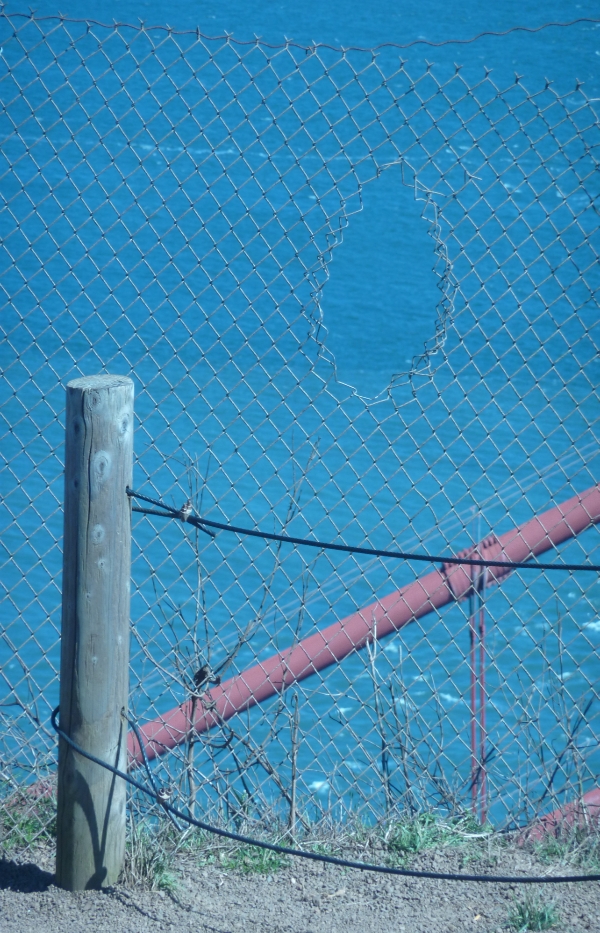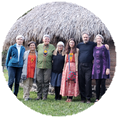Sometimes, well often if I am being perfectly honest, I feel as if I am living my life gazing through a hole in the fence of society. The view I really want is there, where the barbed wire has been peeled back, and suddenly my vision is unobstructed. The water, the sky, the city, are clearer through that hole. It wouldn’t be safe to tear down the whole fence, no, because then I could walk very, very close to the edge or someone could throw a large object from a great height or do something crazy and jump with a parachute on their back or without one… I am too afraid to have no fence at all.
I am, fundamentally, an observer. I enjoy going places and witnessing the people who frequent them. In New York City recently I made a pilgrimage from Bergdorf Goodman’s luxury department store to the Occupy Wall Street camp and saw two different Americas; I saw people living on opposite sides of the fence of society. Bergdorf’s is full of every imaginable frivolity: dresses covered in feathers, opulent candelabras, leather handbags, soaps in art-deco shapes and ridiculously expensive costume jewelry. The halls are lined with photos of celebrities attending private parties there, and frighteningly thin women strut with pursed lips while their daughters discuss whether this particular Vera Wang gown is more appropriate for the wedding ceremony or as the reception dress? Of course there is also the rehearsal dinner dress to consider… It is cold, hard, intimidating and everything a girl could dream of in one monument to luxury consumption.
So onward then, my mind chattering longingly at the dizzying amazingness of what I just witnessed, to the Occupy Wall Street camp. On this day in December the Occupy Movement was still a current news story, before it was pushed to the archived internet backwaters as if all discontent has disappeared with the cold ice of winter and a minor dip in unemployment. Part of me had a vision of coming down to the park with inspirational quotes plastered on me and becoming, quite by accident, the leader of the movement. Either that or I was going to make a youtube video spoofing that idea. I wanted to see Occupy’s birthplace and brainstorm for my entrée into high comedy. But when I arrived, I circled around Zugatti Park, and it is more of a small plaza than a park by the way, ready to swear off my Google maps device for leading me to the wrong place, certain this could not be the symbolic headquarters of a national movement.
The park was surrounded by a barricade, a fence protecting society from what was inside. The practically empty space of Zugatti Park had become a dangerous political presence. There was one small entrance guarded by 3 security officers and a few homeless men sitting on a bench. There were 2 protesters standing inside the fence with signs. Although I can’t remember the words, the signs were long-winded and included graphs and depressing facts comparing veteran benefits to military-industrial expenditures and congressional to federal employees’ pensions. As I stood in disbelief at the euthanized presence of what was still in the media a valid social movement, a former occupier happened by to cheer up the final two, and told me a quick version of his story. On the night they put up the fence he tried to reach Zugati but was cordoned 3 blocks away while private security (with NYPD support) threw everyone’s tents, laptops, sleeping bags and the communal library into dump-trucks, hauled them away and arrested anyone who tried to intervene. Meanwhile police helicopters circled the park, and all media access was denied. He told me they were currently looking for a new place to occupy, because now it was just too tough to keep a solid presence in the park with the rules and security guards and fences.
If there is something dangerous to society, it is put behind a fence: prisoners, protestors, the northern border of Mexico… You can peak at it, and see that it is ugly and dirty and dangerous, but it takes a lot of determination and bravery to climb over, to scale a wall and actually touch the other side for yourself, to see if you have anything in common with what’s behind the barbed wire. And why would you? You could lose all that you worked for along the way, you could be contaminated. There are also fences to keep people in: gated communities, income levels, bridge tolls, tuition, taxes, lobbyists, personal trainers, and all sorts of metaphorical fences that protect access to what is rare and privileged and idolized in our society. You can look but you can’t touch, you can try on but you can’t take home, you can lease but you can’t buy. Both sides gaze at each other, curious, fearful, and angry at those who inhabit the other side of the fence. Depending on birth or upbringing we all eventually decide which side of the fence we are on, and that is a matter of how we see ourselves, not our actual socio-economic status. We must decide who we look at with pity and disdain, because the fence is society, and there is always somebody on the other side. The fence is what separates and protects us.
But what about those moments which are universal, that aren’t dictated by income, social status, political belief, or education? What about those moments which are strictly human and unchanged by society’s fences? I can think of a thousand of those moments: gazing at the vastness of stars from the hot hood of a pickup truck, the ocean waves collapsing and the muffled roar when taken beneath the water, sitting by a fire and watching the light dance in the eyes all around, discovering the epic monument of Yosemite’s glacially carved cliffs, eating a good meal after a long hike, falling inexorably in love with the smell of a newborn baby, simply being present in front of a hypnotic candle’s dance and the list grows and grows and fills the imagination with love and wonder. These are my favorite moments. Those moments when then fence is pulled back, the view is unobstructed, and you can see life for what it really is. These are the moments where we get to be ourselves, where we are no longer separate, where we access the core of our being. We live for these moments when we are able to see the world without the fence. Can we remember why we built it?
–Essay and Photograph by Madeline Merritt







Really beautiful writing Madeleine. Rich material for reflection. Thank you!
One word: Fear.
As a society of true consumers, exploiting the plight of fellow humans, we know that there is resentment and out right anger. Sometimes it is white hot. The reality of it is, most (and I mean approaching all) people are cowards. I have seen brave men paralyzed by it as a combat vet, shrinking into the fetal position when faced with probable death; they are frozen. The paralysis of humanity is coming. Few would rather die on there feet than live on their knees. Our Republic and it’s fences are doomed. As 900,000,000 (yeah the number of zeros is right) people starve in one nation alone (sorry India) the rest of the world looks at their situation with relief that they are not on that “side” (yet). Ignorance and apathy are the only real evils in this world. Knowledge and passion, the only good, People don’t lock others out; they lock themselves in. I firmly believe that you are on a brave path, stay the course. “Those that sacrifice freedom for security, deserve neither.” Now that our politicians have found they can bribe society with their own money (actually your’ children and grand kids’) they will build you all the fence you think you need. I say, who needs a fence if you find instead, courage and vigilance to back up your knowledge and passion.
Outstanding piece, few bare themselves.
Very well written and beautifully stated. I especially love the moving imagery and feeling in the last paragraph. Thank you for sharing! Be Well 🙂